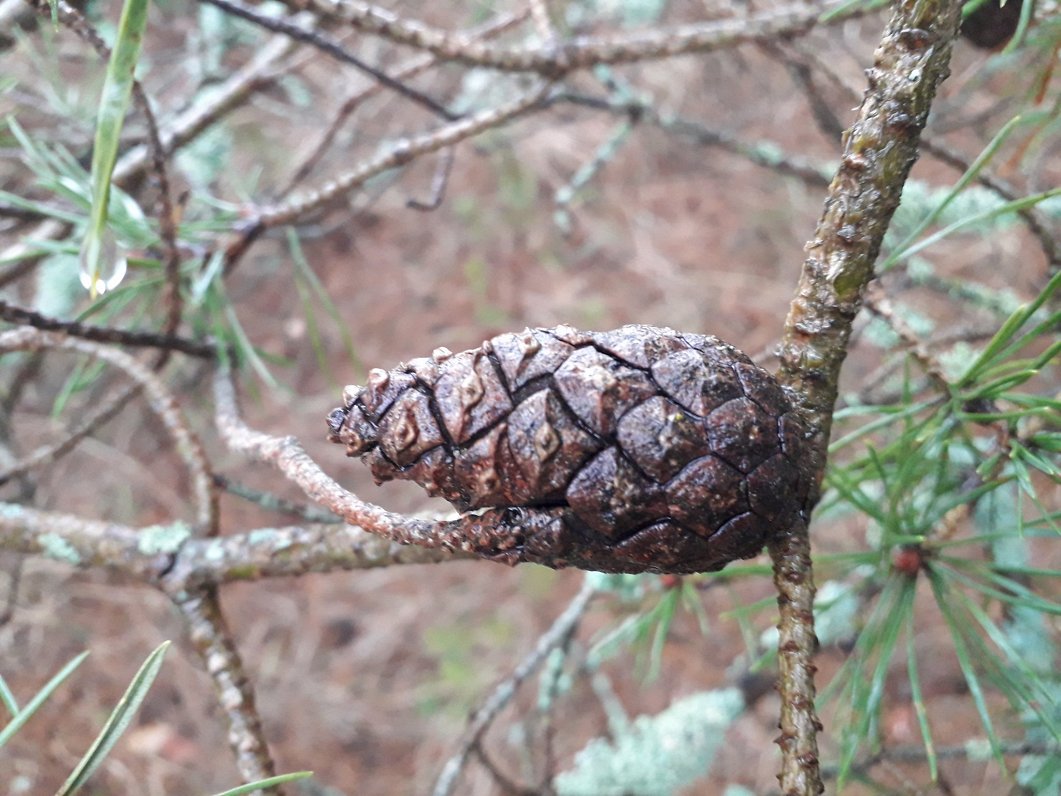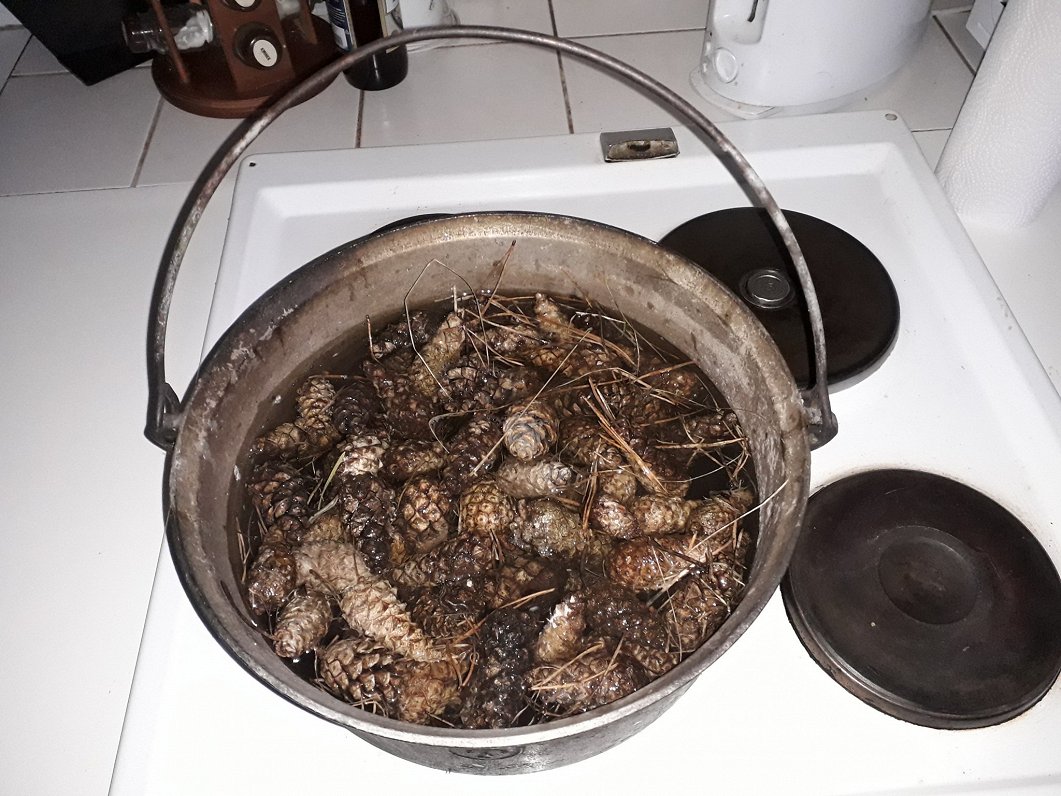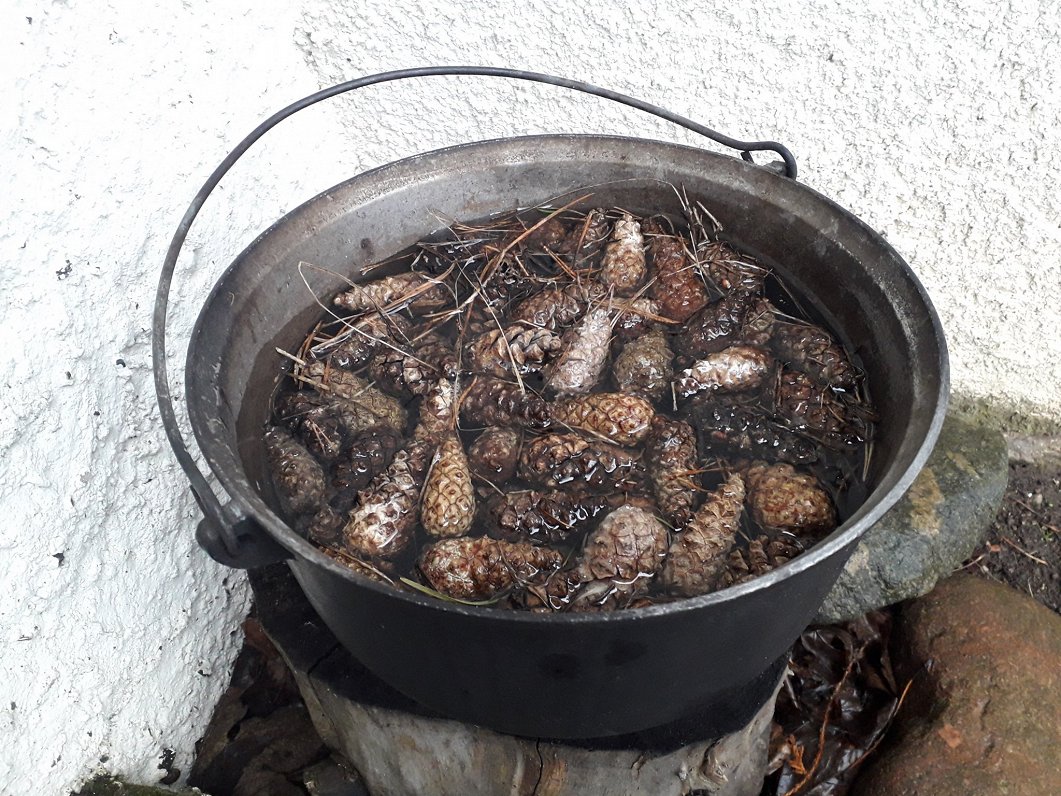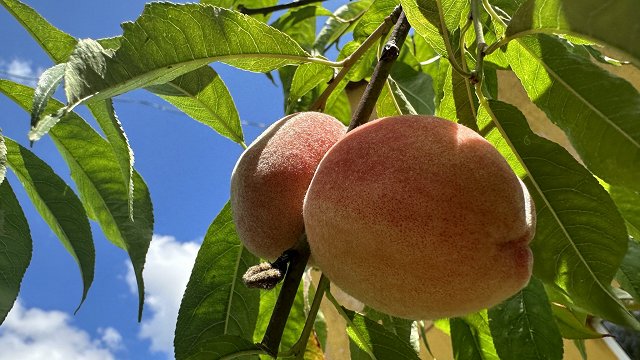The origins of the dish remain obscure but it is generally considered that it originated in the far north-east of the country in the region surrounding the city of Balvi. According to Balvi historical society chairman Norberts Riekstiņš, local folklore and oblique references in Latvia's famous folksongs, the Dainas, suggest that during the dark days of Ivan the Terrible a great famine struck the land.
"Once all the rest of the food had been eaten, people got desperate and started trying anything they could get their hands on that might contain a few calories. Ugly mushrooms, moss, insect eggs, they tried everything. Probably a lot of people got poisoned if they didn't starve. But one old woman, who some say was a witch, hit upon the idea of fermenting pine cones in a pot and eating -- or drinking -- the results. Probably it wasn't exactly tasty but if you could avoid throwing up it saw you through to Spring time."
That, at least, is the legend, and not eating a symbolic bowl of Cold Pine Cone Soup has risked angering the Latvian gods ever since.
Staples of Eastern Livonia
"He who slurps not the soup will be hungry until Midsummer" is a piece of folk wisdom that is almost as well known as the pithy "Eat cold soup hot, have a burned tongue!" which might roughly translate as "Don't try to act clever or it will backfire on you."
Estonian anthropological researcher Mart Mänd of the University of Viljandi is a specialist in the cross-border traditions of Southern Estonia and Northern Latvia, which he jointly refers to as "Eastern Livonia".
"This is only one of many such legends that arose from the famine in Eastern Livonia," Mänd tells LSM.
"In Voru they have similar tales about eating birds' nests. Along the shores of Lake Peipsi it is said there were no fish and therefore the people ate the lichen that they scraped from rocks and formed a sort of rudimentary flour. It is safe to assume that during this period Eastern Livonia was almost totally vegetarian apart from high-status individuals who could afford to have meat imported on the trade route from Novgorod. It was harsh, but it does give us ideas about the possibility of a sustainable lifestyle away from high-intensity farming. I am not saying we should eat pine cones, birds' nests and lichen, but it is something to think about," according to Mänd, who is conducting research on the topic as part of a multi-million-euro EU-NUTS project.
If it started as a desperate necessity that tasted less than appetising, a new breed of cook is reclaiming Cold Pine Cone Soup as part of modern, eco-conscious fusion cuisine.

La Dolce Vita, Latvian style
Rīga-based chef Veronika Lazdiņa was originally from Balvi but trained at the prestigious 'La Fossa' restaurant in Lombardy, Italy and it was there she rediscovered the culinary riches at which she had previously turned her nose up. Today she runs the trendy 'Rīgatoni' restaurant in the Latvian capital which is renowned for its combination of wild Latvian produce and Italian regional dishes.
"I remember my granny making Cold Pine Cone Soup for us. I'd like to say it was delicious, but it wasn't. We hated it, it tasted like turpentine!" she laughs.
While in Italy she told Michelin-starred head chef Giambattista Nizza about Cold Pine Cone Soup and he immediately demanded granny's recipe. Months of experimentation followed, at the conclusion of which the temperamental genius was convinced he had discovered the secret to successful soup: maceration and lengthy fermentation with the help of Modena balsamic vinegar.
"Now I think granny just put the fresh pine cones in a bowl and served it to us," laughs Lazdiņa.
Nevertheless granny's humble dish had found its way onto one of Europe's most prestigious menus as Zuppa fredda di cono di pino with a single bowl costing 25 euros.
"One diner asked for it to be heated up. Hot pine cone soup! Nizza told him to eat it cold or leave the restaurant," laughs Lazdina. What happened? "He ate it cold. We checked his Instagram feed and he even took a photo of it!"
Presidential 'Pardon?'
And now Cold Pine Cone Soup has received the ultimate gastronomic seal of approval. Lazdiņa prepared her signature dish for inclusion on the menu of the official state banquet during the recent visit of French President Emmanuel Macron as Soupe froide aux pommes de pin.
"Initially he thought it was a bouillabaisse, but President Levits explained that it was Cold Pine Cone Soup and demonstrated the traditional way of eating it, which is with a loud slurp from a wooden ladle. The slurp is necessary to get oxygen into the liquid to prevent it becoming overpowering. President Macron did as he was instructed and said it was "Very interesting". If the President of France says a dish is very interesting, it is certainly very interesting!" laughs Lazdiņa.

Any pine cones can be used to make the soup, but those of the mature Baltic pine (Pinus sylvestris) are most prized for their rich, nutty taste. However, it's best to avoid pines from the sea shore, which develop an acrid, salty tang. Similarly, cones located in industrial or polluted areas should not be collected for culinary use.
But for true cordon bleu quality Cold Pine Cone Soup, only pine cones sourced from Latvian State Forests' Vijciems pine cone drying facility will do. This venerable 125-year-old institution has been preserving and processing pine cones using traditional methods for decades, ostensibly for the purposes of replanting but with culinary use an increasingly profitable by-product.
Nor are the benefits of Cold Pine Cone Soup merely culinary. According to researchers, it contains several important and health-giving compounds including corporeal anticarbonalic histozomes, rydebial phostocostates and pan-nucleic enzomatoids. However, care should be taken not to over-ferment the mixture or unpleasant side-effects can occur, the most serious of which are hallucinations that can last up to a week.
According to Mart Mänd, just such an episode was thought to be the inspiration behind Rainis' famous epic poem "Koki mani vajā" (The trees are chasing me), which describes how a man becomes lost between three pine trees and ends up climbing them. Mänd likens the great writer's experience to the shamanic rituals of Amazonian tribal cultures.
"Rainis' diary suggests that Aspazija had made some Cold Pine Cone Soup for him at their Jūrmala summer house, but she had either made it too strong, or left it fermenting too long, or he forgot to slurp while eating. The result may have been psychologically terrifying, but it is this soup we can thank for one of the great works of Baltic literature."

How to make Cold Pine Cone Soup
You will need
1 kilo of ripe pine cones
10 litres of fresh spring water
Vinegar (preferably balsamic, though any vinegar will do)
1 bay leaf
Peppercorns
Method
- In mid-January, place the pine cones into the largest metal cauldron you can find
- Smash them violently with a heavy wooden ladle or mallet for an hour.
- Let the pine cones rest for 24 hours
- Smash them for another hour
- Repeat this process for a week
- Pour in the water
- Add the bay leaf, peppercorns, and 200 ml of vinegar
- Let the mixture stand in a cool, well-ventilated space for 2 months while it ferments. Do NOT cover it with a lid, but with a piece of muslin or an old pair or stockings.
- Strain and serve cold on the first day of April, with liberal amounts of dill.





















